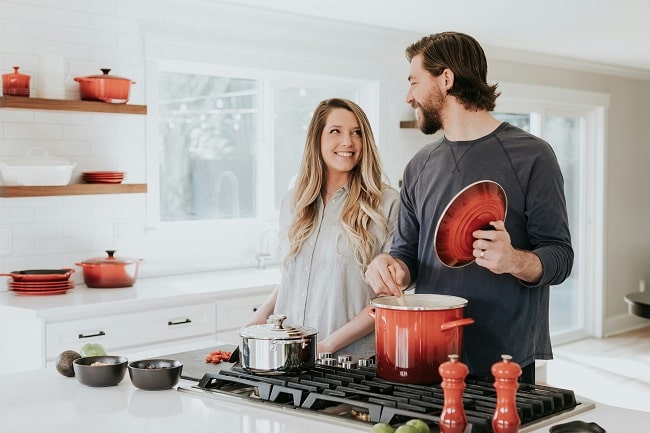As winter approaches, the urge for warm, comforting meals becomes irresistible. But while ovens and stovetops can turn out delicious winter fare, they’re not always the most energy-efficient options. Enter the humble slow cooker and crockpot, which are excellent for creating hearty, flavorful meals with minimal energy consumption. Slow cookers allow you to enjoy warming soups, stews, casseroles, and roasts, all while reducing energy use and keeping your kitchen cozy and comfortable.
Let’s dive into the benefits of using slow cookers for winter meals, how they save energy, and some delicious recipe ideas to keep you warm without racking up high utility bills.
Why Choose Energy-Efficient Cooking in Winter?
Winter is typically a season of high energy use due to heating, increased indoor activity, and holiday festivities. Choosing energy-efficient cooking methods helps reduce your carbon footprint, lower your utility costs, and minimize the load on your home’s heating systems.
Benefits of Energy-Efficient Winter Cooking
- Lower Utility Bills: Slow cookers consume significantly less electricity than ovens or stovetops.
- Environmentally Friendly: Reduced energy use means a smaller environmental impact.
- Effortless Meal Prep: Slow cookers make it easy to prepare meals with minimal effort and fewer cooking appliances.
- Enhanced Comfort: Slow cookers release less heat than ovens, helping to keep your kitchen cozy without overheating your home.
Slow Cookers and Crockpots: Energy Efficiency in Action
Slow cookers and crockpots use low, consistent heat over an extended period, which makes them perfect for energy-efficient winter cooking. While the terms “slow cooker” and “crockpot” are often used interchangeably, they both have unique features but share similar energy-saving benefits.
How Slow Cookers Save Energy
- Low Wattage: Slow cookers operate on low wattage, typically between 70–250 watts on low, compared to an oven that can use up to 3000 watts.
- Minimal Heat Loss: Slow cookers are insulated and designed to cook food evenly, meaning they retain heat effectively and don’t require reheating.
- One-Pot Efficiency: With slow cookers, you can prepare complete meals in one pot, reducing the need for multiple burners or appliances.
- Set-and-Forget Convenience: Slow cookers allow you to prepare meals in advance, so you’re not using energy for long periods, unlike with stovetops or ovens.
Tips for Energy-Efficient Cooking with Slow Cookers and Crockpots
Using slow cookers efficiently maximizes energy savings and enhances flavor. Here are some essential tips to get the most out of your slow cooker during winter:
Use the Right Size
Select a slow cooker that fits the size of your meal. Filling your slow cooker to 50-75% capacity allows for optimal cooking and reduces the need for reheating or using multiple appliances.
Opt for Recipes with Longer Cooking Times
Recipes that cook on low for 6–8 hours are ideal for energy-efficient slow cooking. The low, extended cooking time maximizes energy savings and yields tender, flavorful meals.
Limit Lid Lifting
Every time you lift the lid of your slow cooker, it releases heat, extending cooking time and increasing energy consumption. Avoid lifting the lid to check your food until it’s close to being done.
Batch Cooking
Use your slow cooker to batch-cook soups, stews, or grains. Portion out meals for the week and refrigerate or freeze leftovers to reduce the need for additional cooking.
Choose Ingredients That Benefit from Slow Cooking
Certain ingredients like root vegetables, beans, lentils, and tougher cuts of meat become incredibly tender when cooked over long periods at low temperatures, maximizing flavor and minimizing waste.
Pre-Warm Ingredients
Bringing ingredients closer to room temperature before adding them to the slow cooker can help reduce the initial cooking time and energy usage.
Delicious Energy-Saving Winter Recipes for Slow Cookers
Now that you’re set to cook with your slow cooker in a more energy-efficient way, here are some easy, warming recipes that are perfect for winter.
Hearty Vegetable and Lentil Stew
This nutrient-packed vegetable and lentil stew is ideal for cold winter days. It’s budget-friendly, plant-based, and easy to prepare.
Ingredients:
- 1 cup dried lentils, rinsed
- 3 carrots, chopped
- 2 celery stalks, chopped
- 2 potatoes, cubed
- 1 onion, chopped
- 3 cloves garlic, minced
- 1 can diced tomatoes
- 4 cups vegetable broth
- 1 tsp thyme
- 1 tsp rosemary
- Salt and pepper to taste
Instructions:
- Add all ingredients to the slow cooker and stir to combine.
- Cook on low for 6–8 hours or until vegetables and lentils are tender.
- Season with salt and pepper to taste before serving.
Energy Tip: Make a double batch and freeze the leftovers for an easy reheat meal later in the week!
Slow Cooker Beef and Barley Soup
This hearty beef and barley soup is packed with protein and fiber, perfect for warming up on cold winter nights.
Ingredients:
- 1 lb stewing beef, cubed
- 3 carrots, sliced
- 2 celery stalks, chopped
- 1 onion, diced
- 1 cup pearl barley
- 4 cups beef broth
- 2 cups water
- 2 tsp Worcestershire sauce
- 1 bay leaf
- Salt and pepper to taste
Instructions:
- Place beef, carrots, celery, onion, and barley in the slow cooker.
- Pour in beef broth, water, and Worcestershire sauce, then add the bay leaf.
- Cook on low for 8 hours or until beef and barley are tender.
- Remove bay leaf, season with salt and pepper, and serve warm.
Energy Tip: Use a lower-cost cut of meat, like chuck, for the best results in a slow cooker and optimal energy efficiency.
Crockpot Chicken and Vegetable Curry
Spice up winter nights with this rich and creamy chicken and vegetable curry. It’s flavorful, filling, and perfect for batch cooking.
Ingredients:
- 1 lb boneless, skinless chicken thighs, cubed
- 1 onion, chopped
- 3 cloves garlic, minced
- 1 cup coconut milk
- 1 cup chicken broth
- 1 bell pepper, sliced
- 1 cup cubed butternut squash
- 2 tbsp curry powder
- Salt and pepper to taste
Instructions:
- Add all ingredients to the slow cooker and mix well.
- Cook on low for 6–7 hours or until chicken and vegetables are tender.
- Serve with rice or bread.
Energy Tip: Add frozen vegetables towards the end of cooking for a quick, energy-efficient boost to the recipe.
Creamy Potato and Leek Soup
This creamy potato and leek soup is simple, affordable, and a classic comfort food that’s perfect for winter evenings.
Ingredients:
- 4 large potatoes, peeled and cubed
- 2 leeks, cleaned and sliced
- 4 cups vegetable broth
- 1 cup milk or cream
- Salt and pepper to taste
- Chives for garnish (optional)
Instructions:
- Combine potatoes, leeks, and vegetable broth in the slow cooker.
- Cook on low for 6–8 hours until potatoes are soft.
- Use an immersion blender to blend the soup to desired consistency, then stir in milk or cream.
- Season with salt and pepper, and garnish with chives if desired.
Energy Tip: Use a lower setting on the slow cooker and let it cook throughout the day for maximum energy efficiency.
Additional Tips for Energy-Efficient Cooking in Winter
In addition to slow cookers and crockpots, there are other strategies to make winter cooking more energy-efficient.
Use Smaller Appliances
Consider using toaster ovens, air fryers, or microwaves for smaller meals. These appliances typically use less energy than conventional ovens.
Batch Bake and Store
When using the oven, batch cook or bake items to avoid reheating. Bake multiple dishes at once and freeze portions for future meals.
Insulate Your Slow Cooker
Place a towel or slow cooker liner around the slow cooker (but never over it) to trap heat and reduce cooking time slightly. This improves energy efficiency.
Use a Pressure Cooker for Faster Cooking
Pressure cookers (including electric ones like the Instant Pot) cook meals faster than slow cookers, often with similar results. For recipes that don’t require extended cooking, this option saves time and energy.
Utilize Leftovers
Always make the most of leftovers. Reheat meals using the microwave or stovetop to conserve energy, rather than the oven.
Frequently Asked Questions
How much energy do slow cookers save compared to ovens?
Slow cookers use about 70–250 watts on low, whereas ovens can use up to 3000 watts, making slow cookers significantly more energy-efficient.
Can I cook frozen ingredients in a slow cooker?
While it’s safe to add frozen vegetables towards the end of cooking, avoid starting with frozen meats, as they can increase the risk of bacterial growth during the slow heating process.
What other appliances are energy-efficient for winter cooking?
Electric pressure cookers, toaster ovens, and microwaves are also energy-efficient alternatives for cooking in winter.
Are slow cookers safe to leave on while I’m away?
Yes, slow cookers are designed to cook food safely at low temperatures over extended periods, making them ideal for hands-off cooking.
Can slow cooker recipes be doubled?
Yes, as long as your slow cooker can accommodate the increased volume, you can double recipes for batch cooking.
Conclusion
Embracing energy-efficient winter cooking with slow cookers and crockpots provides a cozy, economical, and sustainable way to enjoy delicious meals throughout the season. With a little planning and these easy, hearty recipes, you can save both energy and time while still savoring the warmth and comfort of home-cooked food. So this winter, give your oven a rest, pull out your slow cooker, and enjoy the benefits of low-energy, high-flavor meals!

